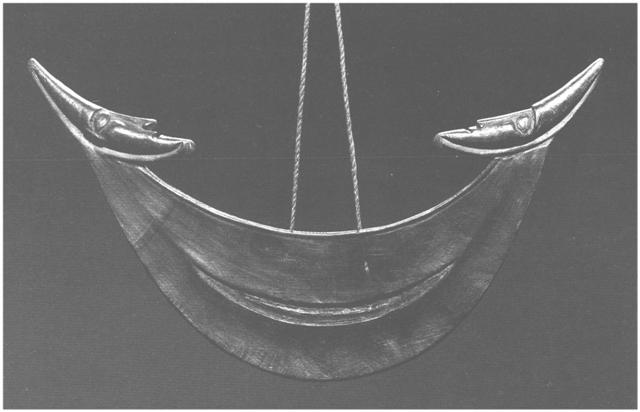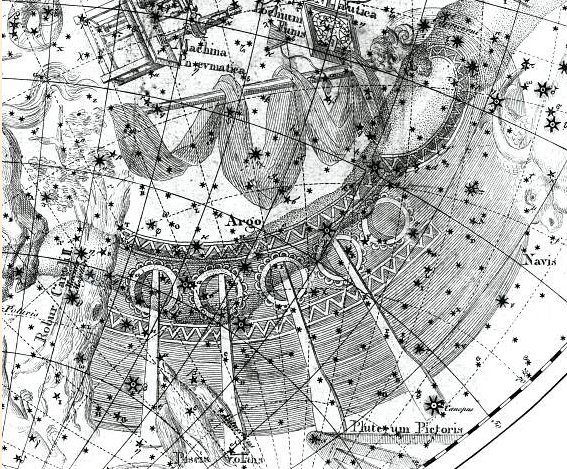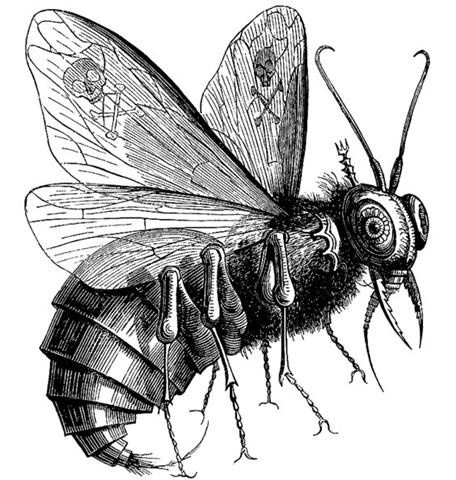520. It was the Moon god, Thoth, who had invented the numbers.
The broken Argo Ship here below is illustrated with 4 oars, as if to suggest a resemblance with the 4 weeks in a month, one for each quarter of the Moon:
The last oar is at Canopus (or rather the first oar because here right ascension time runs from right to left). Furthermore, there is a 5th 'quarter' with no oar, which should remind us of Maui potiki: ... Maui was the fifth and youngest of his parents' sons, yet when he was born his brothers knew nothing of it. They first learned that they had a brother when he was discovered one night standing behind them in the great meeting house. Everyone was present, the four brothers, their mother Taranga, and all the relations, and there was dancing going on, when little Maui crept into the house unseen, and went and sat behind his brothers. When it came to their turn to dance, and their mother stood them up and counted them so as to be ready, he stood up with them. 'One, that's Maui mua; two, that's Maui roto; three, that's Maui taha; four, that's Maui pae', she said; these names mean Maui the first, Maui the middle, Maui the side, and Maui the edge. Then she saw this other child standing with them, and cried out, 'Hullo, where did this one come from?' 'I'm your child too', Maui replied. So she counted them again and said, 'Oh no, there ought to be only four of you. This is the first I've seen of you.' And so there was a scene, with little Maui and the old woman arguing about it in the middle of the rows of dancers. In the end she became annoyed with him. 'Now, come on, out of the house!' she said. 'You are no child of mine, you belong to someone else. Go home!' But little Maui stood up for himself. 'Well then, I'd better go, I suppose', he said. 'Since you say so, I must be someone else's child. But I did think I was yours, because I know I was born at the edge of the sea, and you cut off a tuft of your hair and wrapped me in it and threw me in the waves. After that the seaweed took care of me and I drifted about in the sea, wrapped in long tangles of kelp, until a breeze blew me on shore again, and some jelly-fish rolled themself around me to protect me on the sandy beach. Clouds of flies settled on me and I might have been eaten up by the maggots; flocks of seabirds came, and I might have been pecked to pieces. But then my great-ancestor Tama nui ki te rangi arrived. He saw the clouds of flies and all the birds, and he came and pulled away the jelly-fish, and there was I, a human being! Well, he picked me up and washed me and took me home, and hung me in the rafters in the warmth of the fire, and he saved my life. And I grew, and eventually I heard about the dancing you have here in this house, and that is what brought me here tonight.' Now Taranga listened to all this in amazement. For in the custom of our people, if a child was born before it finished growing in its mother's womb and died without knowing any of the pleasures of life, it was supposed to be buried with special prayers and ceremonies, otherwise it became a kind of evil spirit, always doing mischief to the human race and hurting them out of spite, because of having missed the happiness that they enjoy. All the evil spirits had a beginning of this sort. So Maui was a little demi-god of mischief. The story he had told was true, and as his mother listened she remembered it all. 'From the time I was in your womb,' Maui went on, 'I have known the names of these children of yours. Listen,' he said as he pointed to his brothers in turn. 'You are Maui mua, you are Maui roto, you are Maui taha, and you are Maui pae. And as for me, I am Maui potiki, Maui-the-last-born. And here I am.' When he had finished, Taranga had to wipe her eyes because there were tears in them, and she said: 'You are indeed my lastborn son. You are the child of my old age. When I had you, no one knew, and what you have been saying is the truth. Well, as you were formed out of my topknot you can be Maui tikitiki a Taranga.' So that became his name, meaning Maui-formed-in-the-topknot-of-Taranga. And this is very strange, because women in those days did not have topknots. The topknot was the most sacred part of a person, and only men had them ...
... We can conclude that Maui was born at Sirrah - the Topknot (tikitiki) of Andromeda (Taranga) - ... the progeny of Tu increased: Rongo, Tane, Tangaroa, Rongomai, Kahukura, Tiki, Uru, Ngangana, Io, Iorangi, Waiorangi, Tahu, Moko, Maroro, Wakehau, Tiki, Toi, Rauru, Whatonga - these were the sons ...(Moriori myth of creation accoding to Legends of the South Seas) and also that he was born beyond her regular 4 sons (quarters), for the precession had carried all of them ahead and now the place of her Topknot was 11 + 80 = 91 right ascension days beyond the solstice, viz. at the northern spring equinox (as defined by Gregory XIII). Or the precession could have carried them all 5 * 20 = 100 (April 10) days ahead:
Presumably the well known faces (phases) of the Moon were used to explain the behaviour of the Sun. There could have been 8 'oars' for his ship, a set of 4 on each side, quite similar to the pair of months - equal like twins - which were needed in order to reach the end of the bicycle of 2 * 29½ = 59 nights.
... The Celtic year was divided into two halves with the second half beginning in July, apparently after a seven-day wake, or funeral feast, in the oak-king's honour ...
The natural numbers as such will not create more than a rather limited web of associations for us modern common minds. But there are creative artists who can help. The 5 oar holes above are surrounded by small half-circles with double rims and we can count:
Assuming also the other side of the Ship - not visible - being the same, we will reach 180 for the rear end (muri) of the Ship. As to its front (mua)
... Robur Carolinum, Charles' Oak, the Quercia of Italy and the Karlseiche of Germany, was formally published by Halley in 1679 in commemoration of the Royal Oak of his patron, Charles II, in which the king had lain hidden for twenty-four hours after his defeat by Cromwell in the battle of Worcester, on the 3rd of September 1651 ... we should notice that here the Full Moon in a way may just have moved past night number 348 (= 12 * 29), cfr below. No wonder the king had disappeared, for at the ancient time of the Bull this corresponded to the last night of the year (365 = 348 + 17) and the Sun had lost his battle with the Serpent (Water Snake).
Although in rongorongo times the precession would have moved the stars a little ahead since the time of Halley: AD 1842 - 1679 = 163 or approximately 2 precessional days. And we should remember that my date JULY 1 is only a construct for finding order - no true Sun date. Instead the stars seem to have carried with them the ancient day positions of the Sun. I.e., September 3 - evidently to be associated with the Oak - was the day when the Sun reached the Guards in Ursa Major and the Full Moon reached the beginning of the Pegasus Square (the Fore Spout). We cannot make sense of this if we allow our current Sun calendar dates to continue beyond Sirius - who caused the waters to rise: ... The Sothic cycle was based on what is referred to in technical jargon as 'the periodic return of the heliacal rising of Sirius', which is the first appearance of this star after a seasonal absence, rising at dawn just ahead of the sun in the eastern portion of the sky. In the case of Sirius the interval between one such rising and the next amounts to exactly 365.25 days - a mathematically harmonious figure, uncomplicated by further decimal points, which is just twelve minutes longer than the duration of the solar year ... ... In ancient Egypt they thought Sirius was behind the yearly rise of the Nile ... the seasonal cycle, throughout the ancient world, was the foremost sign of rebirth following death, and in Egypt the chronometer of this cycle was the annual flooding of the Nile ... 246 - 181 = 63 (= 9 weeks).
... Men's spirits were thought to dwell in the Milky Way between incarnations.
This conception has been handed down as an Orphic and Pythagorean tradition fitting into the frame of the migration of the soul. Macrobius, who has provided the broadest report on the matter, has it that souls ascend by way of Capricorn, and then, in order to be reborn, descend again through the 'Gate of Cancer' ... ... From a religious point of view, the high regard for flies, whose increase or reduction causes a similar increase or reduction in the size of the human population, is interesting, even more so because swarms of flies are often a real nuisance on Easter Island, something most visitors have commented on in vivid language. The explanation seems to be that there is a parallel relationship between flies and human souls, in this case, the souls of the unborn. There is a widespread belief throughout Polynesia that insects are the embodiment of numinous beings, such as gods or the spirits of the dead, and this concept extends into Southeast Asia, where insects are seen as the embodiment of the soul ...
|
|||||||||||||||||||||||||||||||||||||||||||||||||||||||||||||||||||||||||||||||||||||||||||||||||||||||||||||||||||||||||||||||||||||||||||||||||||||||||||||||||||||||||||||||||||||||||||||||||||||||||||||||||||||||||||||||||||||||||||||||





.jpg)






.jpg)

